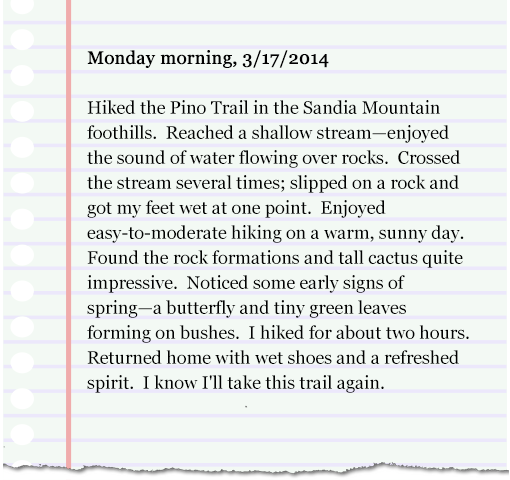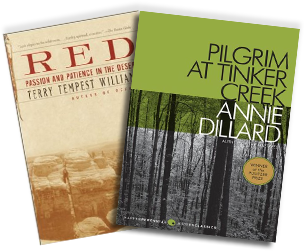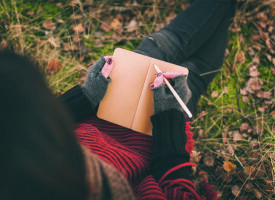I’ve been keeping a nature journal on and off over the past twenty-five years and have found it helpful in deepening my connection with nature. By journaling, I’ve become more observant of the sights, sounds, scents, and feel of what’s around me in the natural world. I notice, for example, not just the fact that I’m walking through a forest or a grove of trees but that individual trees have unique characteristics—some have leaves shaped like stars, some have seeds that rattle in the wind, and some have bark as smooth as sanded wood. I like to record these observations along with unusual or surprising sightings, like a porcupine in the branches of a cottonwood tree or a family of quails in our backyard. One day, my surprise was finding a hummingbird’s nest with the tiniest eggs I’ve ever seen. I date my journal entries and find it interesting to compare my observations of particular places and things in nature from one season to another and from one year to another.
I enjoy hiking and have started adding a log of my hikes in my nature journal. Whether I’m on a week-long hut-to-hut hike in Europe or a short day hike near my house, I’ll record which trails I took, how difficult they were, how long I hiked, and what I saw or experienced along the way.
Example:

As you can see, I don’t always use complete sentences and often add a note about what I enjoyed. My log, in other words, isn’t just a record of where I went and what I saw. Nature journaling, for me, is much more personal.
Some people like to keep a garden journal to record times of planting and harvesting. While such a journal or log may focus primarily on basic information—what was planted, when it was planted, how it grew, etc.—it may also include some personal experiences and insights. For example, I once included in my nature journal something I remembered my mother saying while we planted a garden: “We need to grow vegetables to have something to eat, but we need to grow flowers to make us smile.”
When I first started nature journaling, I used an ordinary spiral-bound notebook to record my experiences and thoughts. I later switched to blank journals—the kind you can find at many stationary or book stores. This made the process more inviting and gives the journal a more enduring quality.
 Nature journaling isn’t new. A number of famous naturalists—including John Muir, Aldo Leopold, and Henry David Thoreau—kept nature journals during much of their adult lives. Some of the published works of current day writers also take the form of nature journals. These include Annie Dillard in her book, Pilgrim at Tinkers Creek, and Terry Tempest Williams in Red: Passion and Patience in the Desert.
Nature journaling isn’t new. A number of famous naturalists—including John Muir, Aldo Leopold, and Henry David Thoreau—kept nature journals during much of their adult lives. Some of the published works of current day writers also take the form of nature journals. These include Annie Dillard in her book, Pilgrim at Tinkers Creek, and Terry Tempest Williams in Red: Passion and Patience in the Desert.
But you don’t have to have dreams of publishing your nature journal to enjoy and benefit from the process. Keeping a Nature Journal will help you see the natural world in a new light and, over time, deepen your relationship with the Earth.
Here are some ideas for getting started:
1.
Spend time outdoors and make a special effort to engage all your senses in experiencing the natural world. See it, hear it, smell it, touch it, and taste it. Engage your sense of intuition and wonder, as well.
2.
Open your mind and heart to learn new things about the world of nature. Don’t let preconceived ideas limit what you see and feel. Pay special attention to patterns, motions, sounds, temperature, and light.
3.
Consider selecting one special place you can visit over time to notice how it changes from season to season.
4.
Use a special notebook for your nature journal, and record your observations frequently. Feel free to use either poetry or prose—or both. You may also wish to add drawings or photos.
5.
Avoid being critical of your writing—it doesn’t need to be polished. It’s best to be spontaneous in recording your observations and insights.
6.
Read the work of other nature writers. In addition to the ones already mentioned, you might also read the writings of Gary Snyder, Diane Ackerman, Gretel Ehrlich, Barry Lopez, and Ralph Waldo Emerson.
7.
Once you start a nature journal, you’ll find yourself becoming more in tune with the natural world and your relationship with it will deepen. Over time, you’ll find that the world of nature will become less of an “it” out there to be observed and used and more of an exciting entity of which you are a part.
Enjoy the journey!
About the author:
Dr. Ruth Wilson works as an educational consultant and curriculum writer, with special expertise in the areas of early childhood environmental education and the development of language and literacy. Dr. Wilson’s career includes working as a classroom teacher in both regular and special education settings and as a teacher educator for over ten years at Bowling Green State University in Ohio.
Dr. Wilson’s published books include Nature and Young Children, Fostering a Sense of Wonder during the Early Childhood Years, and Special Educational Needs in the Early Years. Dr. Wilson’s articles have appeared in numerous publications including Environmental Education Research Journal, Green Teacher, Early Childhood News, Exchange, and American Forests. Dr. Wilson lives and works in Albuquerque, NM. She can be contacted at [email protected].
Also by Ruth Wilson:
1. Writing Poetry for Children (article)
2. How to Use the Power of Poetry to Enhance Your Writing and Life (article)
3. Writing Your Ecological Autobiography


